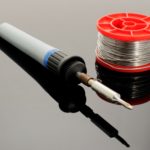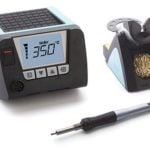Solder the Right Way, The First Time
One way to avoid junking your favorite electronic devices, guitars, audio equipment, power supplies, power cords, cables, and more is by learning how to solder them back to life. Fixing a shorted wire, bad connection, or entirely defunct electronic device is often simple with a quality soldering iron, well-picked accessories, some safety precautions, and a few YouTube tutorials.
Investing in a Quality Soldering Iron Saves Countless Hours and Headaches
Higher-end soldering irons heat up quickly, repeatably, and use digital temperature displays for predictable function. When a soldering iron tip comes into a contact with another material, the thermal energy which was stored in the tip is dissipated into the joint. With cheap soldering irons, the temperature output isn’t adjustable and the tip of the iron often waivers drastically between too hot or too cool. Unlike adjustable temperature soldering stations, fixed temperature soldering irons struggle in practical use for novice and experienced users alike.
“The key to the problem lies with the fact that fixed temperature soldering irons are philosophically not designed to manage thermal energy. Instead, the heater, which is usually ceramic, is turned on if the embedded temperature sensor reads too high and off if the sensor reads too low. In practice, when the heater controller receives the signal to turn on, the tip temperature will have already fallen below its set point. The heater is then run at its maximum power to increase the tip temperature and will invariably cause the temperature to overshoot.” — Brazing & Soldering Today
The Winning Tip
Optimizing the mass and dimension of the tip facilitates the proper amount of heat transfer for the given job. For electronics, overly large tips store excessive energy and limit precision for tight placements. Soldering irons with interchangeable tips improve cross-functional use for any project and ensure easy replacement for life-long use. “Tinning” the tip of a new soldering iron is critical for lasting function and effective heat transfer. Working on small devices with limited access and the wrong sized tip leads to twisting and moving the iron around to achieve heat transfer. The result is errors, inadequate joints, and long hold times which compromise the final results.
“The best possible tip shape is not excessively long, is smoothly tapered, has a chisel-shaped face that should be matched in size to the joint, and does not have excessive plating thickness. It should have sufficient mass to help deliver the necessary energy into the thermal load to raise the solder alloy above its melting point within an acceptable time.” — Brazing & Soldering Today
Is the Wattage of the Soldering Iron Important?
More wattage doesn’t imply more heat, but instead, that power is more available. Premium soldering irons with higher wattage ratings heat solder more quickly to achieve a molten state without long holding periods and excessive heat. Holding periods of more than five seconds easily melt surrounding plastics, wire insulation, other joints, and can destroy circuitry. Higher wattage also ensures that the operating temperature remains consistent as the tip will experience a smaller drop when applied to joints. Low-end soldering irons usually feature 15W – 20W power supplies without temperature adjustment, whereas 40W – 60W irons with adjustable temperature output accommodate most projects.
Spending the extra money on quality components with a higher wattage rating gets you the most productivity with the least amount of headaches. Likewise, using the right solder is key to efficient processes and protecting delicate components from damage.
What’s the Best Type of Solder to Use?
Before getting started, note the fundamental properties of fusible metal alloys (solder) and ensure you’ve found the proper material for the job. Do not buy acid flux solder; it’s used for plumbing and destroys electronics!
Different solder materials yield varying degrees of “plasticity”. Plasticity indicates a temperature range, affecting the duration in which solder remains molten after being heated to a melting temperature. Electronic and printed circuit board (PCB) users prefer solder with a combination of 37 % lead 63 % tin (63/37 Sn/Pb) because it features the lowest melting point (183 °C or 361.4 °F) of all tin alloys, and the melting point is a true melting point, not a range. Quick melting and return to solid limits heat transfer to components and facilitates in-and-out joint creation. This is ideal for sensitive or tightly spaced components or when holding a wire by hand.
Solder with a rosin flux core is generally used for soldering electronics. The rosin flux facilitates adhesion of the tin and lead by cleaning and lubricating metal wires or surfaces before attachment. Fine 0.020” (0.5mm) solder is preferred with small components, while general applications often use 0.032” (0.8128mm) solder. Lead-free solder is readily available, but it’s harder to work with, more expensive, and melts at higher temperatures. Lead and tin based solder is far more forgiving and heats and cools almost instantly, which is ideal for novices. This post does not cover the scope of soldering PCBs which may require “no-clean flux” which eliminates the potential of flux residue to damage sensitive circuits.
Is Lead-Based Solder Safe?
Lead is toxic, but its high boiling temperature of 3,182°F (1,750°C) minimizes exposure to fumes. The smoke created during the soldering process is almost entirely produced by the rosin flux, which is toxic when inhaled. Solder with caution and never in poorly ventilated areas, as the side effects could be instantaneous or develop long-term with repeated exposure. Smoke absorbing fans and air flow help mitigate exposure to nasty chemicals for hobbyist projects, whereas commercial users opt for fume extractors.
Is There Anything Else I Need for Soldering?
When working with electronic components the risk of electrostatic discharge (ESD) is constant. The root cause of ESD stems from the friction of insulators like rubber and plastic which don’t conduct electricity well. Sparks created when this electricity finds a pathway to the ground through an electronic component can destroy or damage sensitive devices and even cause explosions when fumes are abundant. Anti-static devices such as wrist straps and grounding mats reduce, dampen, and inhibit the buildup and discharge of static electricity.
Lastly, don’t underestimate the important of a quality (and sharp) wire stripper. Cleanly stripped and cut wires without loose or frayed ends ensure quality connections and desirable conductivity.
Investing in quality equipment ensures the function you need now, and the durability you’ll need for lasting use and future projects.
Related Posts
- Metcal MX-5000 Soldering System
The new MX-5000 Series Soldering & Rework System is the next generation of the trusted Metcal Soldering Systems that will enable you to increase productivity and process control for a wide range of applications with…
- Hakko FM-204 Desoldering Station
This is our second to last post in our Hakko free shipping promotion. Today we'll focus on the Hakko FM-204 Desoldering Station. In electronics, "desoldering" is the removal of solder and components from a circuit for…
-
Everything You've Ever Wanted to Know About Soldering
We ran into this fantastic soldering demo on YouTube using PACE equipment. View Production Automation's YouTube Channel View all the PACE products Production Automation offers
- Hakko FX-888 Soldering Station
Continuing on our Hakko product focus, today we'll look at the Hakko FX-888 Soldering Station. Please keep in mind that the items that were blogged yesterday, and the rest of the Hakko products that will…
-
How to Tin a Soldering Tip
The proper use and care of the soldering tip will increase soldering production and decrease solder joint failure. Properly caring for your soldering tip increases their life as well as the quality of the soldering. Here…
-
A Compact Review of Weller's WT Soldering System
According to Weller, the WT soldering stations represent the world’s first soldering system with replaceable, passive, high-performance soldering tips.







